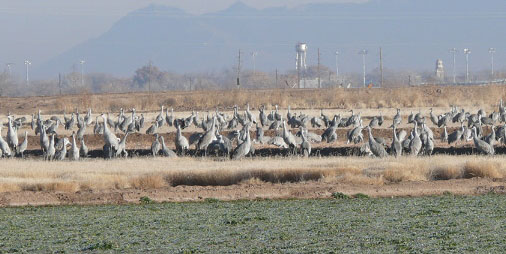|
Sandhill Crane Hunt in New Mexico  Each fall, during the first week of October, the sandhill cranes begin to arrive for their winter stay in the Middle Rio Grande Valley. At first, only a few hundred arrive; however, by the end of the month, there are literally thousands. By the time all of the cranes have arrived from the north, there are flocks of more than 10,000 birds foraging along the river. Early morning, large flocks move from the river into the fields around our house, often flying so low that they have to gain altitude at the last moment to avoid a collision with our barn. Then, as the sun sets, they rise en mass and head back to the river for the night. When they overwinter in New Mexico, the Greater and Lesser Sandhills are mixed together and virtually impossible to tell apart, except for size. The Lesser Sandhills are big birds, weighing in at 10-12 pounds, while the Greater Sandhills are even larger, often reaching 18-20 pounds. These are all very tough birds and a real challenge for any hunter. They came close to extinction in the 1930�s due to unrestricted market hunting. Crane populations have since rebounded to present numbers that probably exceed 650,000. With so many birds overwintering in the Rio Grande Valley, you would be correct in surmising that they wreack havoc on winter crops. Across the road from our place there is an experimental station for plant science research and the workers are continuously scaring the cranes off their newly planted fields. New Mexico issues a limited number of hunting permits by draw each year. They have four, two day hunts in the MRGV, with a daily bag limit of three and a possession limit of six. We�ve been in our present location for almost twenty years and never put in for a crane permit. Not sure why. Probably because of conflicts with our deer and elk hunting. However, if we do decide to hunt for crane, it would be an easy matter to take our shotguns out behind the barn, sit down with a cup of coffee and wait. Between 0700 and 0830, from October through March, they fly low across our place in continuous waves. I am talking low enough that you have to dodge their droppings when a large flock passes and there have been occasions when Jim zigged when he should have zagged! If you have stopped laughing at that image, we will get on with the story. In October, a professor at the medical school approached Jim about crane hunting. The doctor had drawn out for the December 4-5 hunt and was going to go out with a friend from Albuquerque. He asked Jim if knew a good place to hunt crane. Jim told him about a couple spots down on the Rio Grande about four miles from our house, OR, he could come by our place for coffee and wait for them to fly over the barn. As opening day approached, they rang us up and asked if the crane were still flying over the barn and they were. However, they decided to try the river in the morning in the hopes of filling out. They didn't figured on the other 70 crane hunters being in the same area. As such, they only got one crane in the morning. The other hunters completely misjudged the distances of the birds and began firing when they were 100 yards out. Couple that with the birds flying a lot faster than most folks realize and you have a recipe for a lot of misses. If you don�t lead crane by a fair amount, you�ll be blasting air. That is exactly what most of the river hunters did. Frustrated by the crowd of sky-blasters, they came by the house in the afternoon. The field across the road was loaded with crane. However, I told them that there was no way that they could approach them within range. The birds were already spooky from being shot at on the river. Therefore, my hunters stationed themselves beside the barn (with coffee) and waited. Just before sunset, right on cue, the waves of crane lifted off the field and headed back to the river, flying over our barn. Within half an hour, they had dropped three very large cranes. My neighbor and I acted as bird dogs, trotting out into the field to retrieve the downed birds. It was great fun, while it lasted. The last of the cranes had headed for the river and the sky was clear as the sun sank in the west. Tomorrow would be another day. It didn�t take much convincing for them to decide to return the next morning, instead of fighting the crowd on the river. However, it was a bit disappointing, as the birds were changing their flight pattern, due to all the shooting on the river. The crane had obviously learned that flying over the barn wasn�t as safe as it used to be. They were flying higher and faster than normal. However, my hunters did manage to drop two birds. All things considered, they had a pretty good hunt for a couple of guys that had never hunted crane before. Six birds, weighing from 12 � 18 pounds, and all clean kills. I imagine that both men will be applying for crane permits again, and so will we! BTW, if you breast them out and barbecue them on the grill, add a bit of salt, pepper and sauce, you have a meal fit for a king (or queen). Author's Addendum: Since this article was originally published, we have received inquiries every month asking about the loads our hunters were shooting. They were using HEVI-Metal #2 and #4 shot from Environ-Metal Inc., Sweet Home, Oregon. Since we can't argue with success, we have stocked-up on HEVI-shot in preparation for the 2011- 2012 waterfowl season. |